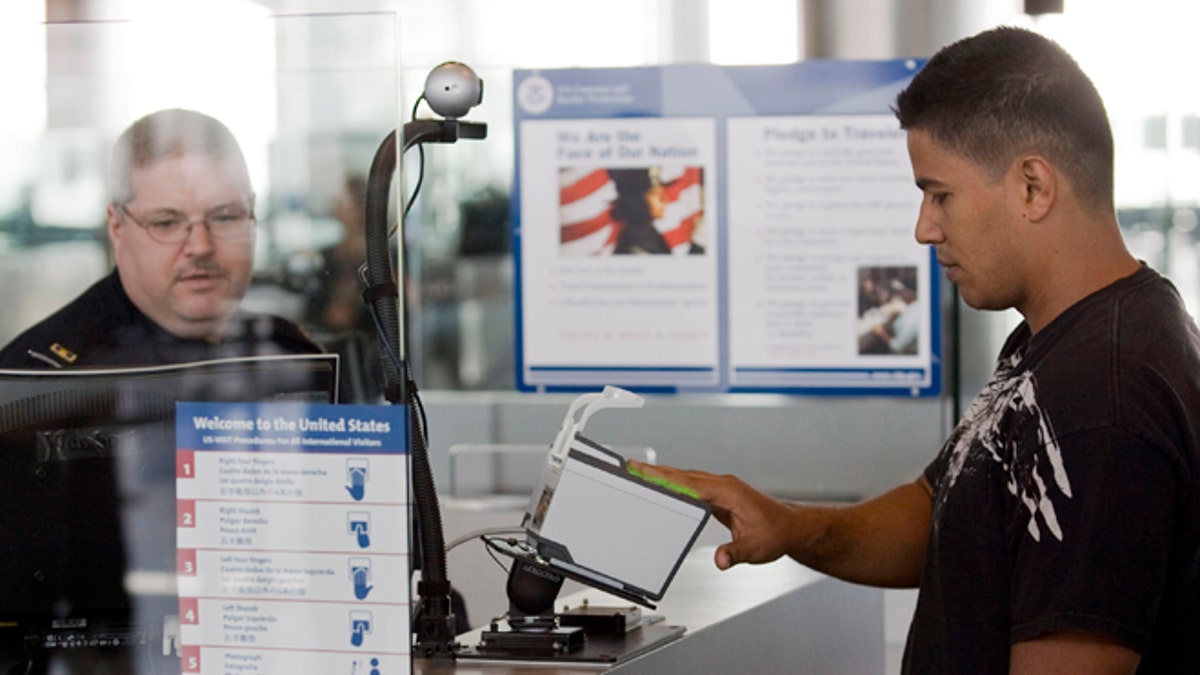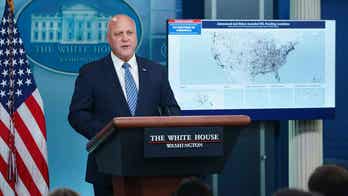
HOUSTON - FEBRUARY 1: U.S. Customs and Border Protection officer Thomas Wuenschel (L) monitors his screen as an arriving passenger uses a new biometric scanner at George H. W. Bush Intercontinental Airport February 1, 2008 in Houston, Texas. The new system is set up to scan all ten fingers instead of the two finger scanners previously used. (Photo by Dave Einsel/Getty Images) (2008 Getty Images)
Following revelations that several of the September 11, 2001, terrorists were in the United States on expired visas, lawmakers and activists on both sides of the political divide have debated what to do when immigrants arrive into the country legally but then don’t leave.
On the suggestions of the 9/11 Commission, the Department of Homeland Security (DHS) created a visa entry system that fingerprints anyone coming into the country through a U.S. airport and now checks those prints with a database to identify any criminal or security threats.
But on the 12th anniversary of 9/11 terror attacks – and as the House of Representatives continues to mull over a proposed comprehensive immigration reform bill – there are new concerns about the effectiveness and reach of the “entry-exit” visa system, which was created by Congress in 1996.
“We need to know who is in the country, when they’re supposed to depart, and when they actually leave,” Sen. Chuck Grassley (R-Iowa) told Congress in June. “Unfortunately, administration after administration dismissed the need to implement an effective entry-exit system. So, here we are today – 17 years later – wondering when that system and that mandate from Congress will be achieved.”
U.S. airports were never configured to check people leaving the country and the DHS has been trying for 10 years to figure out how the heck to do exits.
One of the biggest issues facing both DHS and Congress is how to effectively track people leaving the country. While the current system is able to use fingerprints and log people entering the U.S. – a system for monitoring people exiting, and overstaying their visas, has yet to be implemented.
“The exit system is the problem,” Edward Alden, an immigration expert at the Council of Foreign Relations, told Fox News Latino. “U.S. airports were never configured to check people leaving the country and the DHS has been trying for 10 years to figure out how the heck to do exits.”
Neither side of the immigration debate would argue that a workable exit system is a bad idea. Where they are divided is along some of the finer points such as who is targeted for overstaying visas and how to properly use biometric identification – a system using tools such as fingerprinting and eye scans to identify people – and the economic toll the system would have along U.S.’s land borders.
Using biometrics for visitors leaving the country would allow U.S. authorities to know for certain who has left, how long they were in the country and if they are wanted by authorities. The U.S. currently only uses passports to check on travelers entering the country.
“Passports can be 99 percent accurate, but there can still be discrepancies,” Alden said. “A biometric check would be 100 percent accurate.”
The problem with a biometric system is that it is time-consuming and, if implemented on the U.S.’s land borders with Canada and Mexico, would not only create extended wait times at borders that are already clogged but also hinder the cross-border flow of goods. The U.S. does billions of dollars in trade with Canada and Mexico, which are the country’s first and third largest trade partners, respectively.
“You have to make a clear distinction between land border and airports,” said Doris Meissner, the director of the Migration Policy Institute’s U.S. Immigration Policy program and former acting director of the U.S. Immigration and Naturalization Service – the predecessor to Immigration and Customs Enforcement.
The biometric system could be a viable option in airports since many people travel with visas, experts say. But, some say, the cross-border trade and the fact that much of the land border crossings are local traffic make it almost impossible to put in place without distorting international trade and travel times.
“The problem is that while the system is technically challenging at airports and seaports, it's technically impossible at land border ports of entry,” said Jan Ting, a law professor at Temple University and fellow at the Center for Immigration Studies. “See the high volume of cars departing the U.S. for Mexico every day at the San Diego border crossing. You cannot extract departure information from those border-crossers without creating permanent gridlock at the border.”
Along with border delays, tracking down people who overstay their visas has been a contentious matter in the debate.
Those who favor strict immigration laws, like Grassley and Republican Texas Rep. Lamar Smith, argue that DHS needs to track down every person who overstays a visa. But officials from the U.S. law enforcement agency argue that, given its funding and the time-consuming nature in hunting down the offenders, DHS can only afford to go after people with expired visas who have criminal records or are considered a threat to national security.
Some experts say DHS is doing the best it can with the resources it has. And, they argue, neither the DHS nor lawmakers inside the Beltway have offered reasonable solutions to how to properly track people leaving the U.S.
But some, like Meissner, see other options to solving the overstay issue.
“The exit visa issue is almost insoluble right now,” Meissner told Fox News Latino. “The best thing you can do for visa overstays is not to chase them down but to make it hard for them to get jobs.”




